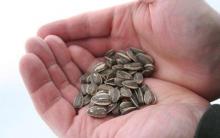Attention! When changing strings or tuning, hold the instrument with the top of the instrument facing away from you. The total tension force of the guitar strings can reach 50 kg. If the string breaks, it can damage your eyes and face. If, when replacing strings, you need to cut the string with a special tool (nippers, etc.), you must completely release its tension in advance. A sudden drop in string tension can not only cause damage to the fretboard, but a snapped string can also injure you. To relieve tension, it is convenient to use special ones (sometimes called stringwinders).
How to change and tighten nylon strings on classical guitar
IN classical guitars ah, nylon strings are most often used. Typically the three strings are made of pure nylon, the three bass strings are complemented by windings of silver plated copper. Use metal strings in a classical guitar it is not recommended - it is simply dangerous: since the instrument is not designed for strong tension, it can collapse on its own, and even cause damage to you.
1. Remove the first string - unwind the peg by hand or using a string winder, remove the string from the peg mechanism on the headstock and then pull it out of the stand (bridge) on the top soundboard.
2. Fastening new string to the stand (bridge). The diagram shows the part of the stand (bridge) and the part of the string that is attached (neck at the top). When attaching the first, second or third string, you can make more turns.
Make sure the last turn of string is at the edge of the bridge.

3. Attaching a new string to the tuning machine. The diagram shows how to install the first string (the second and third are installed in the same way). The fourth, fifth and sixth strings are wound onto the peg in the opposite direction when installed.

4. After installing the strings, you can tune the guitar; use for this.
Please note that immediately after installation, the strings will actively stretch and the guitar may go out of tune very quickly - this is normal. A little later this process will become less noticeable, but the strings will still stretch, and the guitar will have to be adjusted periodically.
How to change and tension metal strings on acoustic guitar
1. Remove the first string - unwind the peg by hand or using a string winder and remove the string from the peg mechanism on the headstock. Then remove the tailpiece (pin) from the stand (bridge) on the top deck of the guitar. If you don’t have a tenacious tool at hand, you can remove it using any coin.

2. Insert the string into the hole, close it with a pin and press it well so that it does not squeeze out when the string is pulled.



3. We bring the free end of the string to the head of the guitar neck and insert it into the hole of the desired peg, then turn the string in the direction opposite to the rotation of the peg (2), pass the tip of the string from below (3) and wrap it around the string going to the soundboard (4). After this, we rotate the peg along the blue arrow (5), the string clamps itself and, thanks to this “lock,” does not slip out of the hole of the peg (6). As a result, there should be 2-3 turns on the peg. If the strings are wound on the pegs without this very “lock”, then the guitar often goes out of tune, because When playing, the strings begin to weaken, even with a large number of turns.

4. Now you can tune the guitar using, for example, .
If the wood of a guitar is the flesh, then the strings are the blood that allows the instrument to flow with life. When the strings of your instrument stop pleasing you with their euphonious, rich sound, a pressing question arises: How to change the strings on a guitar?
When purchasing a new instrument, it is recommended to immediately change the strings. This is due to the fact that guitar strings wear out, and it is almost impossible to predict how long the guitar has been hanging on the counter and what strings are on it. It also happens that the strings lose the brightness of their sound. Most often, it all starts with the fact that thick strings stop sounding richly and lose some of the low overtones, the sound becomes washed out. Today it is not a problem, whether it is metal strings for an acoustic guitar, electric guitar, or bass. But what to do with a pack of strings in your hands? How to string a guitar?
How to change strings on an acoustic guitar

To do this, we gradually loosen the tension of the strings by rotating the pegs, so that, God forbid, we do not injure ourselves by “shooting” or bursting from changes internal stresses string. After the string tips are removed from the bridge tuning heads, the buttons (pins) that hold the strings on the other side of the instrument are removed. The buttons are obtained using a stringwinder, or simply any tenacious tool, for example, a screwdriver or a coin.
- When the strings are removed...
A guitar without strings can be serviced: clean the fingerboard, wipe dust in hard-to-reach places, tighten and lubricate the pegs (if the pegs are open), and replace the top or bottom saddle if necessary.
- How to string a guitar?
After this we move on to installing new strings. It's not so simple anymore.
The strings are installed in a certain order to avoid possible distortion of the guitar neck. First, the third string is installed, followed by the fourth, and so on: second, fifth, first, and the sixth, thickest string completes the string installation process.
 Each string is taken and placed on the bridge pin so that the string fits into the groove and the ball rests against the end. Next is the hairpin along with guitar string is inserted into the corresponding hole in the acoustic guitar stand and pressed.
Each string is taken and placed on the bridge pin so that the string fits into the groove and the ball rests against the end. Next is the hairpin along with guitar string is inserted into the corresponding hole in the acoustic guitar stand and pressed.
 A simpler option is to first lower the string into the hole, which is then closed with a button (pin). When fixing the pin, you need to press on it with sufficient force so that it is not pulled back by the tension of the string; on the other hand, you should not overdo it, because overdoing it can damage the instrument.
A simpler option is to first lower the string into the hole, which is then closed with a button (pin). When fixing the pin, you need to press on it with sufficient force so that it is not pulled back by the tension of the string; on the other hand, you should not overdo it, because overdoing it can damage the instrument.
 Now the free end of the string is threaded into the hole of the corresponding peg from the inside (between the rows of pegs). In this case, it is necessary to leave a small margin of length in order to later wind the string onto the peg (enough to last for 2-4 turns in the future). We bend the free edge of the string (if necessary, you can pre-shape it a little if it gets in the way) and hold it with your finger. Carefully rotate the peg, the turns are placed below the free edge of the string one after another without overlapping. As a result, the string should no longer hang freely on the fingerboard. Here it is important to ensure that the string does not run into the groove for the adjacent string on the top nut.
Now the free end of the string is threaded into the hole of the corresponding peg from the inside (between the rows of pegs). In this case, it is necessary to leave a small margin of length in order to later wind the string onto the peg (enough to last for 2-4 turns in the future). We bend the free edge of the string (if necessary, you can pre-shape it a little if it gets in the way) and hold it with your finger. Carefully rotate the peg, the turns are placed below the free edge of the string one after another without overlapping. As a result, the string should no longer hang freely on the fingerboard. Here it is important to ensure that the string does not run into the groove for the adjacent string on the top nut.
Some guitarists fix the strings on the pegs before winding them using knots. This method is not bad, but it significantly complicates the process of removing the strings the next time you replace them. At the same time, when carefully winding the strings in the manner described above, creating loops seems like a pointless waste of time and may serve more as a means of complacency than to have any real benefits.
However, we will show you how to tie a simple knot. Perhaps at first it will be more reliable to use exactly this option shown below in the diagram.

How to change strings on a classical guitar
Replacement is a little more complicated due to a different method of attaching the string to the bridge of the guitar. However, there are a number of ways to successfully and efficiently install strings on a classical guitar.

Some simply cut with ordinary scissors, and then remove the remains of the strings and pegs and nuts. It would be safer to simply rotate the pegs to gradually release all the strings in the headstock and then pull out the loose strings, and then further remove them from the stand of the classical guitar. It is advisable not to loosen the strings one by one, but to try to gradually loosen all the strings in parallel, so that due to voltage changes, not a single string breaks.
- When a classical guitar no longer has strings
Now that your guitar is left without strings, you can service it, clean it, and penetrate into those places that were difficult for you to reach due to the presence of strings.
- Installing new strings on a classical guitar
Never try to put metal strings on a classical guitar!!! This will certainly lead to deformation of the guitar neck and render the guitar unusable.
Nylon classical guitar strings do not have balls at the end and are more like just pieces of fishing line. Installation of such strings also begins with fixation in the bridge area. At the same time, the fastening of the fourth, fifth and sixth strings differs from the fastening of thinner (first, second and third) strings. As a result, nylon strings with metal winding are installed as follows.



Each string is pulled through the bottom sill and extends outward to a length of about 10 centimeters. Next, a simple loop is made through which the tip of the string is passed. In this case, you should keep the string pressed to the soundboard, otherwise the string will stick out as a result, become loose and may come undone over time. As a result, we have a simple knot that should be tightened. To do this, we strongly pull the edges of the string in different sides. The harder we pull, the less likely it is that the knot will one day fail. However, do not over-tighten the strings to avoid string breaks and excessive pressure on the nut.

The non-wound strings (first, second and third) require a little more complex locking. The beginning of the operation is the same as described above: we stretch the string through the bridge to a length of about 10 centimeters. But then the method has differences: a loop is made through which the tip of the string passes three times. This allows you to secure the string more securely and prevent it from slipping in the future. The knot, accordingly, is tightened as tightly as possible.


As a result, we get the following picture, which indicates that the strings are securely fastened to the bridge. To double check, simply pull each string towards the fingerboard. After this, you can clean up the mess and cut off the protruding ends. Just do not cut the tails at the root, because then there is a risk that the string will come undone.

When all the strings are secured to the nut of the classical guitar, you should secure the free edges of the strings in the tuning mechanism located in the headstock area. The first string (the thinnest) and the sixth (the thickest) are attached to the bottom pegs (closest to the nut and strings), the center strings (third and fourth) are attached to the topmost pegs (closest to the tip of the guitar neck).

Next, we pass the end of each string through the hole of the peg for a length of about 10 centimeters (this is a reserve in case the string is damaged at the point of fixation), wrap it around the sleeve and thread it through the hole again (to fix the string during winding). We also recommend that you first rotate the tuning mechanism so that the holes of all tuning pegs are visible on the front. In this case, you will be better able to see what you are doing, which means it will be easier to cope.
 After this, we rotate the handles of the pegs until a slight string tension is achieved, i.e. when it no longer jumps out of the grooves of the upper threshold. We carry out this operation with each string and only after that we carefully tune the instrument. Once replaced, the nylon strings on a classical guitar will continually go out of tune for several days. Knots take time to fully tighten, but strings have a certain elasticity and should just sit. Thus, at first you will have to adjust the strings quite often, especially if you have classes and, especially, active performances in your plans.
After this, we rotate the handles of the pegs until a slight string tension is achieved, i.e. when it no longer jumps out of the grooves of the upper threshold. We carry out this operation with each string and only after that we carefully tune the instrument. Once replaced, the nylon strings on a classical guitar will continually go out of tune for several days. Knots take time to fully tighten, but strings have a certain elasticity and should just sit. Thus, at first you will have to adjust the strings quite often, especially if you have classes and, especially, active performances in your plans.
I have an electric guitar or bass guitar and I still don’t understand how to change the strings
If you have an electric guitar or bass guitar, then do not worry; the principle of replacing strings in this case is similar to that used in an acoustic guitar. Yes, the design of the tools is slightly different, but the approach remains the same. You're probably wondering why this article doesn't say a word about tuning guitars? We will certainly look at this issue in our next articles.
If after reading this material you still haven’t been able to figure out how to change the strings on a guitar, then we look forward to seeing you in our store, where a qualified sales consultant will help you update the strings on your instrument and also share many other useful tips.
To understand the principle string tension guitar, let's first look at the types of strings. They are metal and synthetic.
Metal ones are more stretched than synthetic ones and are used in guitars with reinforced construction (those with a truss rod). Putting them on a classical guitar is a thankless task and can result in damage to an expensive instrument, but they are louder than synthetic ones.
Synthetic - find their application for classical guitars. They are durable and very suitable for beginners because... After playing the guitar, my fingers don’t hurt as much as after playing the steel ones.
The first three strings are made of carbon or nylon. The rest are covered with copper or silver-plated windings. Carbon is more durable than nylon, but more expensive.
But as they say, closer to the body)
How to tension nylon strings?
To do this, you need to thread the string through the hole in the guitar stand and secure it according to the picture.
After this, you need to insert it into the hole of the peg you need, not too deep, so that it does not stick out. It was in the USSR that sticky strings were fashionable, but as practice shows, they give nothing but a torn cover.
Wind the rest of the string by hand around the peg clockwise - this is what most guitarists do.
For convenience, I provide a photo of the headstock so that you don’t get confused about which peg the string with which number should be pulled on

After you have placed the strings, you need to tune them using tuning mechanisms. I recommend installing all the strings first, tensioning them until they stop rattling. And then adjust each one separately. Otherwise, you will have to check the standard (for example, with) more times.
You should not immediately tune the nylon strings very precisely, because... they tend to get very upset over quite a long time. So tune your guitar and let it sit for a couple of days. At the same time, adjust the instrument from time to time.
There is a way to quickly tune nylon strings. It consists in the fact that you pull them one and a half to two tones higher standard tuning, repeating this procedure after a couple of hours. But strings stretched in this way “live” less.
Another tip for installing new strings, many guitarists practice it. Before as pull on, they must be pulled out manually. You need to pull it from the top sill to the stand.
Pull the stringsfor electric guitar
First, install them in the electric guitar's tailpiece or stand, depending on the design of the guitar.
On Stratocaster guitars, the tailpiece is located at the back of the body. And, for example, on such models, the design of which is similar to the Gibson SG - it is located on the upper side of the body.
Stringing a guitar with locking action
(Such mechanics are often called Floyd Rose mechanics.)

To string a guitar with a Floyd, first fix the string on the stand, locking it using a screw mechanism. Next, thread its free end into the hole in the fixing sill.
Learn more about how to string a guitar with a locking action below.
- Nip off the ball end using pliers.
- Secure the string in the stand using an L-shaped wrench or some other tool depending on the guitar model.
- Loosen the locking mechanism of the top nut and pull the string through the resulting hole towards the pegs.
- Tighten the string to a height close to the pitch of the desired note using a peg. At the same time, tighten the adjustment screw on the stand to an intermediate position in which the string is not yet too tight.
- Tighten the lock located on the top sill.
- Bring the sound to the reference level using the adjustment screw.
- Carry out the procedures described above for the remaining 5 strings.
- Another important addition. If you change the strings to thinner ones- do not forget release the springs inside the housing. This is done in order to compensate for the reduced tension of thinner strings.
If you have unscrewed the adjustment screw all the way, release the lock on the top saddle, put the adjustment screw in an intermediate position, tighten the string with a peg and tighten the lock.
How to string a guitar with a regular tuning mechanism?
- Secure the string in the stand and pull it towards the pegs. Without pulling, the string often does not fall into place and this can create extra work for you when tensioning it.
- Thread it into the peg you need, leaving some slack (for strings with braid - 5 cm, without it - 10 cm).
- Bend the string in the direction of rotation of the peg. Most often counterclockwise.
- Pull the string with a peg, while holding it in tension with your free hand to wind the turns more tightly.
- When it has tightened up a little, insert it into the slot in the top sill.
- Stretch it as in the case with nylon guitar. When stretching, adjust the string again and again until you get it to stay in tune.
- Use pliers to bite off the remaining piece of string.
That's it, the guitar is tuned. Enjoy your game!
Now that the instrument is without strings, it’s time to make a marafet for our pegs. We turn the instrument over with the back side up, and if you have pegs of about the same type as mine, take a screwdriver and tighten all the screws until they stop. If the pegs are of a closed type, you first need to remove the cap and do the same.
On both acoustic and electric guitars, the tuning mechanisms, as well as other fastening parts, are always weakened by the resonance of the wood - this is normal. You can also immediately lubricate the rotating mechanisms with graphite paste or machine oil. Apply lubricant and rotate the peg ten times forward, then back, so that the entire worm mechanism is lubricated. Remove excess grease with a napkin. 
Also, while there are no strings, you need to tidy up the neck and soundboard of the guitar, cleaning the surfaces from dirt and dust. Do not use alcohol to clean the fretboard; this should be done with special instrument care products. IN as a last resort do this with a dry cloth, because... working part The neck is lubricated with special oil at the factory (at least it should be)
Well, that's all you need to do before installing new strings. 
Now we can install the strings.
String installation order: 3;4;2;5;1;6;
This installation order is required to avoid skewing the neck.
We take the string and place it on the tailpiece so that the string fits into the groove and rests with its barrel against the end of the tailpiece. 
Then we insert the tailpiece along with the string into the hole and press it against the body, but not too hard so as not to break the guitar (I have heard of such a case) 

Now that we have inserted the tailpiece into the body and have not broken the instrument, we thread the second edge of the string into the hole of the peg from the inside (between the rows of pegs) 
We leave 8 centimeters of string at the exit and we can bite off the rest with wire cutters, or then remove the excess. We bend the short edge of the string, and holding the finger on the fingerboard under tension, we turn the peg until the string stops hanging from the fingerboard. There is no need to tighten too much just yet. I don’t tie any knots, (then it’s only more difficult to untangle them when replacing strings), I threaded the string into the hole, and underneath it down
the remaining turns. The guitar will stay in tune normally, unless the pegs are broken, of course. There should be up to 4 turns on the tuner, there is no need for more, and there is no need to overlap the turns either, this will not make the guitar stay in tune better; on the contrary, you will then suffer with tuning. 


That's all for installing the strings. As you can see, nothing complicated.
I wish you success!!!
You won't have to go to extraordinary lengths to change the strings on your electric guitar, but there are some nuances to the string changing process that you should know. Although this article is aimed at beginners, more experienced musicians may also learn something new.
If you recently purchased an electric guitar, then most likely the strings on it need to be replaced, since new instruments are often equipped with low-quality strings.
How to remove old strings from an electric guitar
First you need to remove installed strings. The two most common ways to do this are:
1. A quick way to remove strings
Snack them with nippers.
Attention! The strings must first be loosened, because the tension force is quite high.
I won’t bore you with terms: you can get injured from a flying string. You need to bite the string near the pickup, holding the long part of the string with your other hand. Having completed the procedure with all the strings, you will quickly remove their remains.
Twist old strings using electric guitar pegs. This method is not as fast as the previous one, but also less dangerous.
How to install new strings on an electric guitar
Winding the string onto the peg
Installing new strings requires some skill. If the strings from the new set are not marked in any way, then I recommend that you sort out the order of the strings from thinnest to thickest in advance. This will allow you to avoid the mistake when it suddenly turns out that the third string will be installed in place of the second.
New strings should be installed on an electric guitar in the following sequence: 6-1, 5-2, 4-3. In this case, the tension will occur symmetrically and will not cause curvature of the bar. However, this is just a recommendation and nothing more.
Thread the string into the holder. Its design depends on the type of guitar you have, and there is no need to describe this stage. I believe that you yourself can figure out how to do this.
Winding new strings onto the pegs of an electric guitar has its own subtleties. Having threaded the string into the tailpiece and into the hole in the peg leg, you need to select the appropriate length of the working part of the string. Those. the length that will fluctuate when playing + the length required to wind a guitar peg with the required number of turns. This skill will come to you with experience, but there is one general recommendation: With the guitar on your knees with the neck to the left, hold the string with your left hand so that it does not jump out of the peg hole, and with your right hand adjust the working length of the string. To do this, lightly pull the string with your index finger. right hand, and place your straight middle finger against the body of the guitar between the pickups. The string length chosen in this way in most cases is, if not optimal, then a starting point.
Next, with the fingers of your left hand, bend the rest of the string upward and begin rotating the peg, tensioning the string. Each subsequent skein of string must go under the previous one. Once the string tension is moderate, move on to the next one.
- First string: 2-4 turns
- Second string: 2-4 turns
- Third string: 2-3 turns
- The remaining strings are 2 turns each.
Because of large quantity turns may cause problems with the tuning of the guitar. Additionally, according to one respected guitar maker: the number of turns affects the response of the guitar body, which in turn affects the sound. On the other hand, due to too few turns, the string may slip/scroll on the peg when it is tensioned.
Now that the new strings are in place, you can begin tuning the guitar. But keep in mind that new strings take 1-2 days to last, so the tuning of your electric guitar will float a little.
Finally, a couple of tips: in order to extend the life of your strings and avoid their corrosion, make it a rule to wash your hands before playing and wipe the strings with a soft cloth after playing. Considering that the average service life of new strings with moderate exercise is 30-50 days, then observing these simple rules you add about another month to their life.











Consequences of tubal ligation during caesarean section
The benefits of sunflower seeds for the heart, hair and nerves
Why do my legs give way at the knees?
Name energy: how the patronymic influences fate and the birth program Name patronymic meaning character
First Chinese Emperor